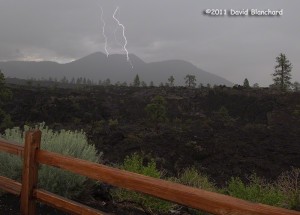It’s been a dry spring—and before that, a dry winter—but the rains have finally arrived. The North American Monsoon has started across Arizona and it’s right on time. The rains usually arrive during the first two weeks of July. Rain started falling on the 2nd of July and hasn’t stopped yet. The average rainfall for July at the Flagstaff airport is 2.61″. We have already had 2.64″ and it’s only the first week. At least one location around town has had even more as shown by the rainfall map below.

Some of these storms have produced copious amounts of small hail. As the vast quantities of hail on the ground chill the near-surface air fog forms and is known appropriately as hail fog.

Most of this hail was pea sized or smaller—nothing large or severe. Even hours after the hail fell there were still piles of it along the side of the road.

It’s only the first week of the rainy season and I’m ready for a day with sunshine.





